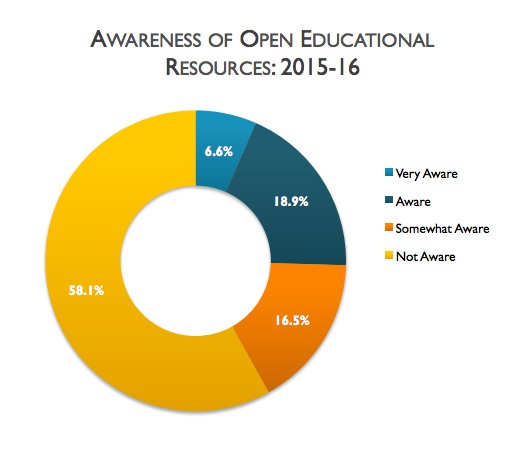Awareness of OER Low, Faculty Willing to Try
A new report from Babson College examines the attitudes, opinions and use of open educational resources among higher education faculty.
Free or open educational resources (OER) appear to have increased in popularity over the last few years, as more state universities and community colleges carry out initiatives to replace traditional textbooks with OER. While institutions are adopting OER, however, the majority of professors and other teaching faculty in higher education are still not aware of OER, according to new report from Babson Survey Research Group (BSRG) at Babson College.
The report “Opening the Textbook: Educational Resources in U.S. Higher Education, 2015-16” incorporates survey results of more than 3,000 teaching faculty and examines attitudes, opinions and use of OER. Overall, the survey paints a mixed picture for OER, where faculty members’ awareness of OER is low but improving.

Research reveals that most of the professors surveyed are not aware of open educational resources.
When faculty members were asked to self-report their awareness of OER, results showed that 25 percent of faculty members are either “aware” or “very aware” of OER, up from 20 percent last year. Still, the majority (58 percent) said they were either “not aware” or “have heard of OER, but don’t know much about them,” according to the report. An additional 17 percent said they were “somewhat aware,” but not sure how to use them.
“While the overall use of OER for required course materials remains low, it is showing progress,” said Jeff Seaman, co-author of the report, in a statement.
For instance, the survey found that professors who teach large enrollment introductory-level courses adopted openly licensed OpenStax college textbooks at twice the rate (10 percent) of other faculty members. The report also indicates that future adoption of OER is on the rise, with close to 31 percent of faculty reporting that they will consider future OER use.
However, inadequate education remains a significant barrier to OER adoption. Many professors cited “there are not enough resources for my subject” (49 percent) and “there is no comprehensive catalog of resources” (45 percent).
In the report, Seaman discusses the serious disconnect between what professors cite as the most important criteria when selecting educational resources and what they actually choose. Cost is the most common factor cited by faculty when selecting resources, yet the vast majority of courses (98 percent) require textbook or non-textbook materials that run up the student bill.
"There is potential for growth for OER, as many faculty report that they are willing to try these resources,” Seaman said in a statement. “However, while faculty cite cost to the student more than any other factor in selecting educational materials, concerns about the time and effort it takes to find and evaluate these materials remains a significant barrier to wider adoption."
To download the full report, visit the BSRG site.
About the Author
Sri Ravipati is Web producer for THE Journal and Campus Technology. She can be reached at [email protected].